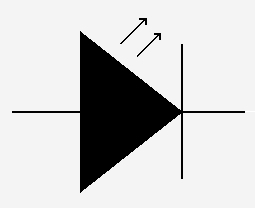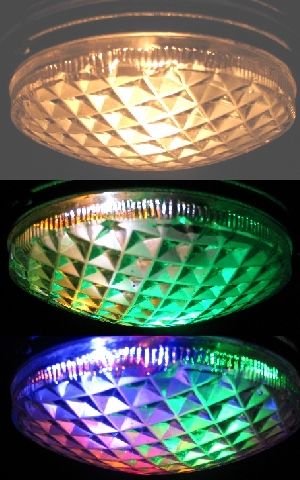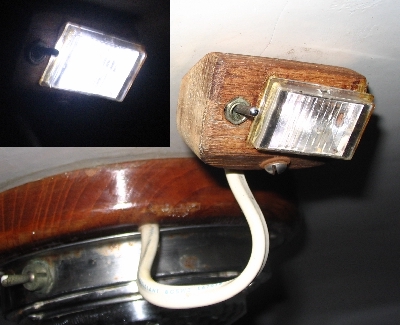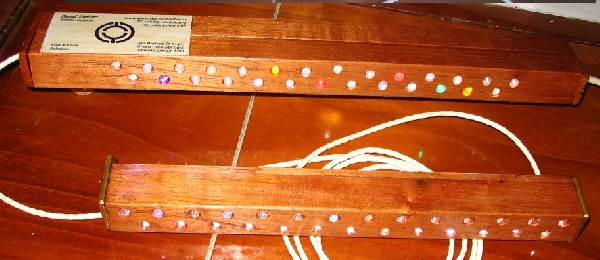
Home Page

LEDs are mounted in dome lights in our boat. We replaced the one way toggle switch with a two way switch so we can have white incandescent light or LED light as the situation dictates. The LED light is somewhat dimmer but uses only 1.5% of the power.

An LED spotlight overhead is a good addition to the galley. We can aim it at the stove or the sink as needed - LED light is highly directional. It is handy when the power is low and we don't want to run the fluorescent light which is much brighter but uses 20 times more power.
Some of the 50 assemblies we made for a fellow cruising couple who charter from their boat in Panama. Their guests, accustomed to life with abundant electricity, often leave cabin lights on. By switching to LED lighting, their peak lighting load will decline from over 30 amps to less than 5 amps (incandescent lamps will be retained in a couple of critical use areas).

Wooden light fixtures for a cockpit and dining table (upper unit is to be fixed-mount and has switches to control both assemblies, lower unit is on a 2 meter cord for remote mounting as needed) - each fixture has 27 LEDs, mostly white but a few colors added for festivity, in red cedar housings, finished with varnish.

An anchor light assembly, with a detail showing the circular array of 18 horizontal LEDs. The bottom of this assembly has 9 vertically oriented LEDs to illuminate an aft ladder. This light is bright, but not US Coast Guard approved.
In September 2005, an article by Cade appeared in "Good Old Boat". This article described how to use LEDs for boat lighting - how to choose appropriate uses and how to design and build the lights from LEDs and other simple components. There is much information on the web about LEDs, but a good place to start is Don Klepstein's LED page. If you are thinking about a lighting plan for a boat, you may also want to consider the Alpenglow Light page. LEDs have also been approved for navigation lights in at least one case. When you are ready to buy some LEDs for a project, a relatively inexpensive source in the USA is All Electronics Corp., though we have found much cheaper devices in latin america where they are not so picky about enforcing intellectual property laws and oriental knock-offs are the only available LEDs (and about 1/6 the price of LEDs at home -> 1,500 pesos each or about US$0.60 each). To obtain top quality products investigate purchase of Nichia LEDs.
If you should happen to have access to library resources, check out “In Pursuit of the Ultimate Lamp” by Craford, Holonyak & Kish, Scientific American, February 2001.
It is difficult to photograph LED lighting since cameras are so keen to adjust light levels in digital images. And of course the human eye is even more adaptable. We cannot really show you how much (or how little?) light a cluster of LEDs can deliver here, but just show some of the ideas for use we have found.
When designing a LED lighting circuit we build as follows:
1. determine the usage and thus the number and orientation of the LEDs.
2. buy sufficient LEDs for the job and measure their voltage drop at 20 mA - LED specifications vary. Do this by placing a single LED in series with a 470 ohm resistor and measuring the voltage drop across the LED alone. Verify that the LED is operating near 20 mA by using Ohm's Law (Voltage = current X resistance) to calculate the current in the resistor. I = V/R = system voltage (around 12.5 to 13.5) - LED voltage / 470 = current in amps (multiply by 1000 for milliamps)
3. LEDs in a series should account for no more than about 80% of the voltage drop. Don't forget to design for the highest voltage at which the LEDs will be operated - on many boats that may be around 14 volts, but select the maximum LEDs for the minimum voltage which is around 12 volts. the total LED voltage drop should be about 80% x 12 = 9.6 volts or about three white LEDs.
4. The rest of the voltage drop to the maximum voltage is caused by the resistor, so 14 - 9.6 = 4.4 volts. The current through LEDs should be kept to about 20 mA, so the resistor should have a value in this example of
R = V/I
= 4.4 / 0.02
= 220 ohms
= 4.4 / 0.02
= 220 ohms
5. After assembly, it is important to carefully seal the circuit since the marine environment will quickly corrode the delicate electrical leads on LEDs and resistors. Use paint or similar sealant film. Remember that resistors dissipate heat, so do not coat the resistor body with an insulating material or the heat may not dissipate and lead to damage in the resistor.
6. In circuits where other boat equipment such as water pumps can cause voltage fluctuations that make the LEDs flicker, install a paralled capacitor of several thousand microfarads to stabilize the voltage in the lighting circuit.